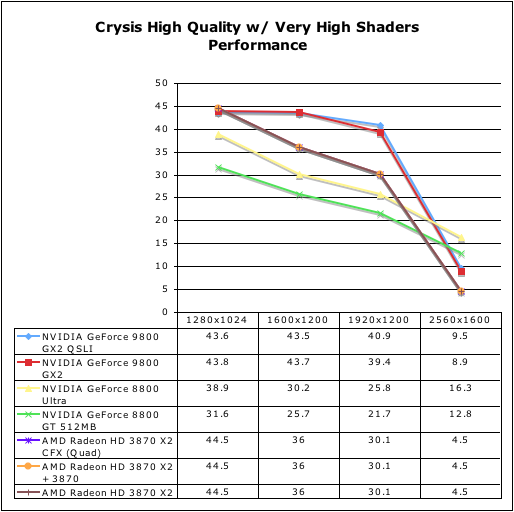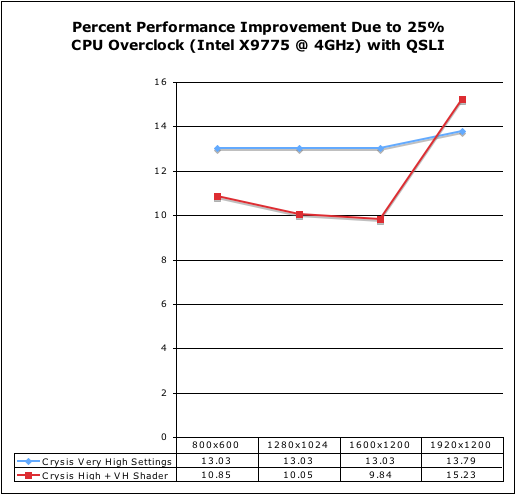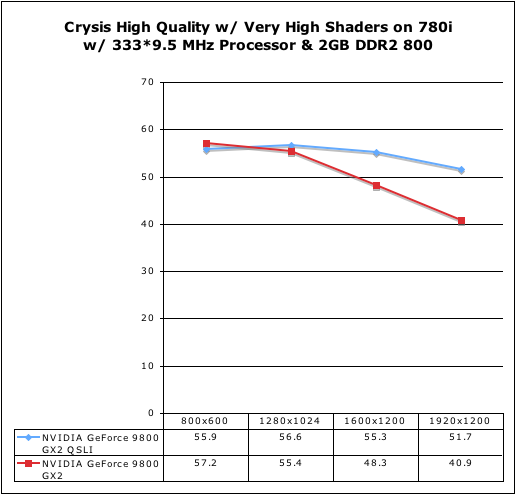Quad SLI with 9800 GX2: Pushing a System to its Limit
by Derek Wilson on March 25, 2008 9:00 AM EST- Posted in
- GPUs
What about Crysis on Very High?
So we tested Crysis on Very high settings with our single 9800 GX2 and Quad setup. Here’s what we got:


As we can see, with very high quality, performance starts to diverge between the dual and quad GPU NVIDIA solutions. It’s also interesting to note that performance doesn’t drop a great deal when moving up in quality. This indicates that the 9800 GX2 is still system bound in some way. And oddly enough, it looks like it is more system bound at the higher quality setting.
To test this absurd theory, we decided to see what happened when we overclocked our 8 CPUs from 3.2 to 4GHz. Let’s test the theory that we are CPU bound to about 45-50 fps at high quality and 40 fps at very high quality. Here is what our 25% overclock netted us when we tested with both very high and high quality using the 9800 GX2 in Quad SLI.

I’ll give you all a second to pick your jaws up off the floor....
Ok, break’s over. We see more than a 50% performance improvement per percent increase in CPU clock speed; a 25% clock speed increase netted us more than half that in real performance under Very High Quality settings. We saw less than 50% improvement at lower res for High Quality plus Very High Shaders until we hit 1920x1200, which netted us a 15% gain on a 25% increase in clock speed.
This indicates that the higher the graphical quality, the MORE CPU bound we are. Crazy isn’t it? It's counter-intuitive, but pure fact. In speaking with NVIDIA about this (they have helped us a lot in understanding some of our issues here), the belief is that more accurate and higher quality physics at higher graphical quality settings is what causes this overhead. Also, keep in mind that we are testing in a timedemo with AI disabled.
And that’s not where it ends. We are platform bound as well. Yes, I said platform bound. A quick check on 780i returned these results:

Not that we are still CPU bound here even though performance is about 25% higher than on Skulltrail (we benefit even more from a platform change than from an overclock). This is with the same speed CPU. It’s quite unfortunate that we stumbled across all of this last night with the help of NVIDIA while trying to troubleshoot our issues. Remember we said that NVIDIA expects a 60% improvement in Crysis at 19x12 with Very High Quality settings. The added number of cores, the fact that I’m only able to run two FB-DIMMS at the moment (for half of the system memory bandwidth I should have), the arrangement of the PCIe lanes on Skulltrail … All of this contributes to our system limitation here and our inability to see scaling from 9800 GX2.
Now, we have seen better performance on Skulltrail in the past, so it is unclear if there is something we can do to remove some of this system limitation at this point. We will certainly be exploring this further as we would still like to make a single platform work for all of our graphics testing. If we can’t then we’ll move on, but it is useful to discover if this is an Intel issue, an OS issue, a driver issue, or something else. If it’s fixable we need to find out how to fix it, as there are probably two or three people out there who’ve purchased a D5400XS board and will not be happy if it performs much worse than 780i boards in cases like this. My working theory right now is that I applied some hotfix or changed some seemingly benign OS setting that caused some problem somewhere. But like I said, we’ll track it down.










54 Comments
View All Comments
DerekWilson - Wednesday, March 26, 2008 - link
we've looked at using the hp blackbird ...the major reason i want to use skulltrail is to compare crossfire to sli.
there are plenty of reasons i'd rather use another platform, but i'd love it if either AMD or NVIDIA would take a step outside of the box and enable either their platform to support other multiGPU configurations or enable their drivers and cards to run in multiGPU configurations on other platforms.
7Enigma - Tuesday, March 25, 2008 - link
It's a slippery slope. We want to be able to say Nvidia is better than ATI (or vice versa), or that future scaling due to architecture will make A better than B. The truth as you pointed out is that it doesn't happen this way in all cases. You can have a A64 3200+ (like I currently do) and throw a GX2 at it and it probably won't perform better than a 9600GT. But that doesn't mean its an equal card, just that in a particular situation it performed the same. It's up to the buyer to do their homework and figure out whether its worth it to drop $650 when their system in current $$$ might not be worth the price of the card....Hocp tried this tactic with the launch of the C2D's and got a lot of heat (I agreed with the anger). They were trying to show that most games are GPU limited and so the new CPU's showed no benefit. Of course it was only a small selection of games, and they didn't take into consideration the 2 largest cpu-straining genre's (RTS and flight sim), and they were running at very high resolutions (which obviously would make things GPU bound).
One of gamespot.com's good features is in their game coverage (pretty much all I use them for). They put out hardware guides that do exactly what you want. They take a specific game and throw a battery of systems at it to see what makes a difference. Those guides will show you just how much improvement you can expect when going from a certain graphics card to a better one on a specific cpu platform. You'll be able to see whether your cpu/mobo combination is at the end of its usable lifespan (ie upgrading other components such as GPU/ram no longer yield a large improvement due to cpu/other bottleneck).
I would say while like you I read these reviews knowing I'll likely never own one of these cards/cpu's, it does give a good picture of who is at the top, and therefore, who has the potential to outlast the other in a system before an upgrade is needed.
With all that said, there is clearly a major problem going on and so all the data generated in this and possibly the previous single GX2 review also benchmarked on the skulltrail platform needs to be taken with a grain of salt, realizing that the numbers could very likely be invalid.
DerekWilson - Tuesday, March 25, 2008 - link
I doubt there is a major problem that would invalidate the data ... and I'm not just saying that because I spent weeks testing and troubleshooting :-)certainly something is going on, but in spite of the fact that 780i performs a bit higher, performance characteristics are exactly the same -- if there is an issue with my setup it is not platform specific.
I'm still tracking issues though ...
chizow - Tuesday, March 25, 2008 - link
Nice job on the review Derek, looks like you ran into some problems but I'd guess testing these new pieces of hardware make it worthwhile.It really looks like Quad SLI scaling is really poor right now, do you think its a case of drivers needing to mature, CPU bottleneck, or frame buffer limitations? I know Vista should be maxed at 4 frame buffers, but there seems to be very little scaling beyond a single GX2 in everything except Crysis (and COD4). In some games, performance actually decreases with the 2nd GX2.
Also, seeing the massive performance difference between Skulltrail and 780i, is it even worthwhile to continue using Skulltrail as a test platform? I understand it makes it more convenient for you guys to test between different GPU vendors, but a 25% difference in Crysis between an NV SLI solution and Intel's SLI solution is rather drastic, and that's *after* you factor in the 2nd CPU for Skulltrail. Does ATI suffer a similar performance hit when compared against its best performing chipset platform?
I would've liked to have seen Tri-SLI compared in there. Personally I think Tri-SLI with 8800 GTX/Ultra and soon, 9800 GTX will outperform Quad-SLI as it seems the drivers are a bit more mature for Tri-SLI and scaling was better as well. SLI performance with those parts is slightly better already than the GX2 and adding that third card should give Tri-SLI the lead over Quad-SLI.
Lastly, how was your actual gameplay experience with these high-end parts? Micro-stutter is a buzz word that has been gaining steam lately with multi-GPU solutions. Did you notice any in your testing? It looks like frame buffer size really kills all of these 512MB parts at 2560, would you consider games at that resolution unplayable? It seems many who considered 2-GX2 or 2-X2 would have done so to play at 2560. If that resolution is unplayable, you're looking at an even smaller window of consumers that would actually buy and benefit from such an expensive set-up.
seamusmc - Wednesday, March 26, 2008 - link
chizow check out Hard OCP's review in regards to 'micro' stutter. They do a great job of presenting the issue and how it affects gameplay.They feel the problem is due to the smaller amount of memory/memory bandwidth on the GX2 as opposed to an 8800 GTX/Ultra.
DerekWilson - Wednesday, March 26, 2008 - link
in my gameplay experience, i had no difficulty with micro stutter and the 9800gx2 in quad sli.i will say that i have run into the problem on crossfirex in oblivion with 4 way at very high res. it wasn't that pronounced or detrimental to the overall experience to me, but i'll make sure to mention it when i run into this problem in the future.
cactusjack - Tuesday, March 25, 2008 - link
Nvidia should go back to making good stable video cards with good IQ instead of flexing their e muscles with crap like this that no one will ever want or need. Nvidia had problems with power issues and vista driver issues on 8 series cards (G92)that they should be working on.raymondse - Tuesday, March 25, 2008 - link
Crysis this, Crysis that. SLI this, CrossFire that...After reading almost a dozen reviews of SLI, Tri-SLI, Quad-SLI, and CrossFire running Crysis and handful of other games, it seems that there is something terribly wrong with the all the benchmarks. Test results show that raw multi-GPU horsepower, even when coupled with multi-CPUs, just isn't delivering the kinds of numbers that most of us were expecting. The potential computing power that this kind of hardware can deliver just doesn't show in the numbers. Something is really, really wrong with one of these components thats disrupting the whole point of going for more than one CPU/GPU.
What I'd like to see is some definitive study showing where the problem(s) is and who to blame. Is it the CPU? GPU? Memory? System Bus? PCI-E? Drivers? DirectX? Windows? or the game/application itself?
After all these tests and benchmarks run by really, really smart people, someone out there ought to be able to deduce who messed up in all this business.
Das Capitolin - Wednesday, April 2, 2008 - link
What I dislike about many reviews, is that they test Crysis on "HIGH" settings. There's a major difference between "HIGH" which doesn't use AA, and HIGH with 16x Q AA.Here's an example of the difference it makes.
http://benchmarkreviews.com/index.php?option=com_c...">http://benchmarkreviews.com/index.php?o...;Itemid=...
Das Capitolin - Wednesday, April 2, 2008 - link
What I dislike about many reviews, is that they test Crysis on "HIGH" settings. There's a major difference between "HIGH" which doesn't use AA, and HIGH with 16x Q AA.Here's an example of the difference it makes.